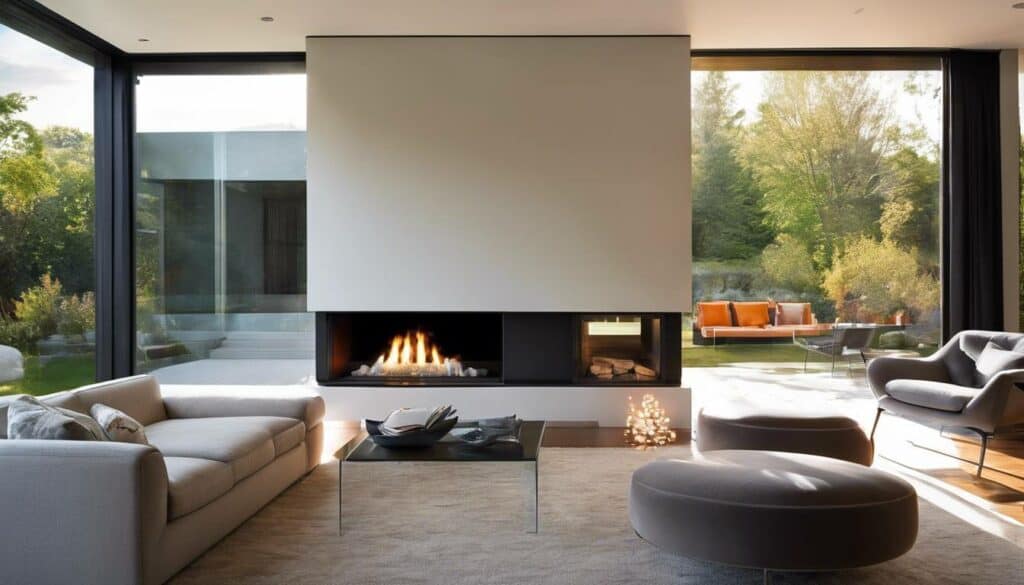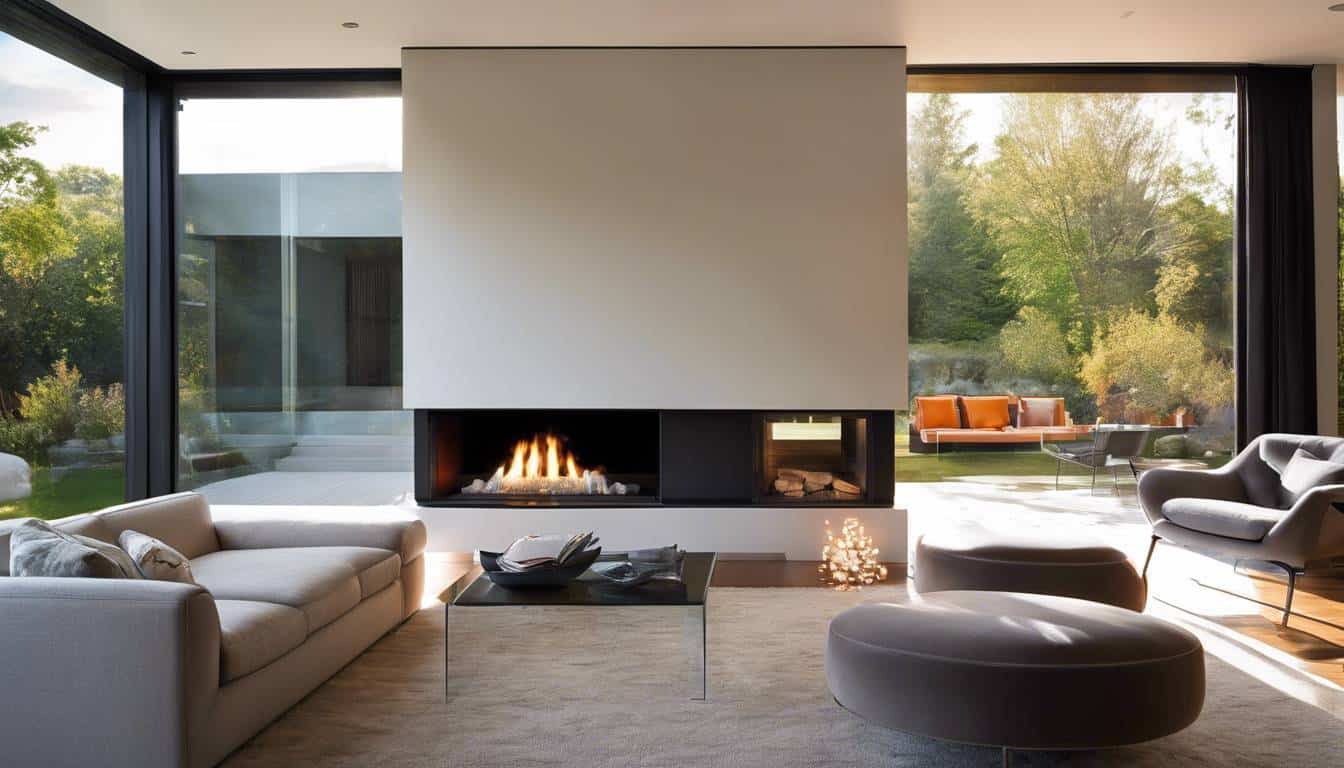When I come home, I grab the remote… not for the TV but rather, for my fireplace. Yes, I finally have a gas fireplace I can turn on and off with the click of a button. It’s a far cry from the traditional wood burners I used to have. I was happy to close up my old wood burning fireplace and replace it. Here’s what I learned: Vented gas fireplaces need a chimney to expel combustion gases safely outside the home while ventless ones don’t. Despite this difference, chimneys in vented fireplaces increase indoor air quality making them a safer option. Surprisingly, these type of fireplaces can utilize an existing properly-cleaned chimney if they are big enough, simplifying installation and providing a cost-effective solution. That momentarily aside, let’s dive a bit deeper into the types of gas fireplaces.
Gas fireplaces can operate with or without a traditional chimney. Vented gas fireplaces require a chimney for proper ventilation, whereas ventless gas fireplaces do not necessarily need a chimney but may require provisions for mitigating harmful gases. This versatility makes gas fireplaces an attractive option for many homeowners. It’s important to consider the type of gas fireplace and consult with a professional to ensure safe and efficient operation.
Gas Fireplaces vs. Vented vs. Ventless
Gas fireplaces are popular for their convenience and efficiency. However, choosing the right type can be overwhelming. There are three main options to consider: gas log sets, ventless gas fireplaces, and vented gas fireplaces. Each has its unique features and considerations.
First, let’s talk about gas log sets. They are often used as an economic alternative to traditional wood-burning fireplaces. They are easy to install and simulate the look of a natural wood-burning fire. However, it’s important to note that gas log sets come with different maintenance and inspection requirements compared to other types of gas fireplaces.
Moving on to vented gas fireplaces, they draw air from outside for combustion and then exhaust fumes back outside, making them a safer option compared to ventless types since they don’t emit any combustion gases into your home. However, you might need some alterations if you want to install an electric fire or use an existing chimney for a vented gas fireplace.
When it comes to ventless gas fireplaces, they operate without needing a chimney and emit some combustion gases into your home. However, modern models are equipped with improved safety measures such as oxygen depletion sensors and specific ventilation requirements. It’s possible to use them at safe levels if you follow the manufacturer’s recommendations and choose an approved model.
It’s essential to understand that each type has its own set of advantages and considerations when it comes to installation, safety, emissions, and maintenance.
Having examined the characteristics of each type of gas fireplace, it’s evident that they all offer distinct benefits and require specific precautions for safe operation. Let’s traverse further into these differences to better understand which type may be most suitable for your home.
Understanding Vented Gas Fireplaces
Vented gas fireplaces connect to a chimney, expelling harmful combustion gases outside the home for a clean and safe indoor environment. The key benefit is effectively reducing indoor concentrations of harmful byproducts like carbon monoxide and nitrogen dioxide, making it a preferred choice for many homeowners seeking an efficient and eco-friendly heating option.
One of the great advantages of vented gas fireplaces is their ability to utilize an existing chimney for installation, saving time and money on construction work. However, it’s important to ensure that the chimney is clean and spacious enough to accommodate the insert to avoid impairing the fireplace’s performance.
Environmental Impact
Additionally, modern gas fireplaces release significantly fewer harmful emissions than traditional wood-burning fireplaces, contributing to improved indoor air quality and promoting a healthier living space for you and your family, thus making them an environmentally conscious choice.
Modern gas fireplaces emit fewer harmful emissions compared to wood-burning fireplaces, making vented gas fireplaces an eco-friendly option.
Regular Maintenance
While vented gas fireplaces offer distinct advantages, they still require regular maintenance to ensure optimal performance and safety. This includes periodic inspections by qualified service technicians to check for blockages or damage within the chimney system and the fireplace itself.
A regular maintenance schedule not only extends the lifespan of your fireplace but also provides peace of mind knowing that your heating appliance is operating safely and efficiently.
By understanding these key features and benefits of vented gas fireplaces, you are well-equipped to make an informed decision about incorporating this heating option into your home.
Understanding the ins and outs of vented gas fireplaces lays a sturdy foundation for exploring the nature of ventless gas fireplaces—a compelling alternative with its own set of advantages and considerations.
The Nature of Ventless Gas Fireplaces
Ventless gas fireplaces operate without the need for a chimney or an external vent, making them a convenient option for homeowners seeking to add the warmth and ambiance of a fireplace without the hassle of complex installation. The absence of a chimney simplifies the installation process, as there are no requirements for venting fumes outside, providing more flexibility in where the fireplace can be placed within a home.
Expanding on this idea, unlike their vented counterparts, ventless gas fireplaces are known for their efficient heat distribution, with a heat output ranging from 20,000 to 40,000 BTUs per hour, offering consistent warmth to the living space. This feature makes them an appealing choice for individuals seeking a reliable and efficient heating solution.
One key consideration with ventless gas fireplaces is their emissions. While they emit some combustion gases into the home, such as water vapor, small amounts of carbon dioxide, nitrogen dioxide, and carbon monoxide are also produced. This is an important factor to consider when evaluating if gas fires are expensive to run and maintain. However, it’s important to note that modern ventless gas fireplaces come equipped with advanced safety features such as an oxygen depletion sensor (ODS). This crucial safety component automatically shuts off the unit if oxygen levels in the room become too low. As a result, when approved and operated according to manufacturer’s guidelines, these contemporary safety measures make ventless gas fireplaces a safer heating option for the home.
The inclusion of an oxygen detection safety sensor is a testament to the continuous advancements in fireplace technology, ensuring that homeowners can enjoy the convenience and comfort of a ventless gas fireplace with peace of mind regarding their safety. These enhancements have achieved significant improvements in reliability and safety standards over time.
For instance, if oxygen levels in the room decrease due to poor ventilation or other factors, the ODS detects this change and promptly shuts off the gas supply to prevent unsafe conditions. This capability offers added reassurance to homeowners, making ventless gas fireplaces a viable option for efficient and safe home heating.
It’s clear that while safety concerns regarding emissions exist with ventless gas fireplaces, technological innovations have transformed them into safer heating alternatives when utilized according to recommended guidelines and approvals.
As we navigate through the realm of home heating solutions, let’s now turn our attention to innovative chimney-free installations—an alternative approach to introducing warmth and elegance into your living space.
Chimney-Free Solutions: Wall and Ceiling Installations
When you think of a “fireplace,” you might imagine a traditional structure built into a cozy living room. But with modern technology, it’s possible to have a fireplace in any room of your house – even if it doesn’t have a chimney. This is where wall or ceiling-mounted ventless gas fireplaces come in. These innovative units offer an elegant and efficient solution for homes lacking the traditional chimney infrastructure. The absence of a chimney does not need to limit where you can enjoy the warmth and ambiance of a fireplace.
First things first, it’s important to understand that the installation of wall or ceiling-mounted ventless gas fireplaces usually requires professional expertise. There are specific guidelines and safety regulations that must be adhered to ensure proper placement and ventilation. Professional installers have the knowledge and experience to guarantee that the unit is mounted securely and that all safety measures are diligently addressed.
Now, let’s consider the convenience and flexibility these solutions provide. Picture this: a sleek, stylish gas fireplace gracing the wall of your study, providing a warm and inviting atmosphere as you delve into a good book. Or imagine an elegant ventless gas fireplace subtly integrated into your bedroom decor, adding both warmth and charm to your personal sanctuary. These possibilities are made attainable through the versatility of wall or ceiling-mounted ventless gas fireplaces.
Imagine lifting your eyes from work at your desk to see the comforting glow of a stunning fireplace on the wall before you—no need for extensive construction or disruptive renovations. This is the kind of aesthetic enhancement these installations offer.
By opting for this type of installation, homeowners can achieve both functionality and style without major upheavals to their home’s architecture. However, it’s essential to remember that precise installation requirements must be met to ensure optimal performance and safety.
Whether it’s about creating an intimate atmosphere or maximizing space utilization, it’s clear that wall or ceiling-mounted ventless gas fireplaces offer a unique solution for modern living spaces lacking traditional chimneys. Their versatility makes them a desirable addition to any home—capable of transforming any room into a cozy haven without compromising on safety or convenience.
Moving from innovative installation options, let’s now shift our focus to the critical elements involved in constructing a chimney for a gas fireplace—all while ensuring safety and efficiency.
How to Construct a Chimney for a Gas Fireplace
Constructing a chimney for a gas fireplace is more than just stacking bricks; it’s a blend of art and science. When opting for a gas fireplace with a chimney, engaging professionals is vital to ensure compliance with building codes and safety standards, essential for your home’s well-being.
Building Codes and Safety Compliance
Building codes guarantee that all structures meet minimum safety and health standards, often dictating chimney height, required clearances from combustible materials, and proper ventilation to prevent dangerous combustion byproducts from lingering in your home. Professional consultation is non-negotiable to ensure compliance with these codes.
Architectural Integrity and Design Specifications
Proper architectural design and construction of the chimney are vital not only for efficient venting of combustion byproducts but also for maintaining structural stability. The size and specifications of the chimney should be carefully planned to prevent heat loss and seamlessly integrate into the aesthetics of your home.
It’s like fitting the last piece of a puzzle—the chimney needs to blend in seamlessly while ensuring optimal functionality.
Professional Expertise
Consulting professionals will provide invaluable insights into suitable materials, dimensions, and building techniques, ensuring that your chimney complies with safety standards and stands as a testament to meticulous workmanship.
When constructing a chimney for a gas fireplace, it’s evident that expertise, precision, and adherence to safety regulations are imperative. Partnering with professionals ensures that your fireplace not only adds warmth to your home but also complies with essential architectural and safety standards.
Key Safety Precautions for Gas Fireplace and Chimney Users
Gas fireplaces provide warmth and ambiance, but it’s essential to always prioritize safety when using them. Regular maintenance is crucial to ensure trouble-free operation and avoid any potential hazards.
One of the most important safety precautions is checking for damp patches and damage caused by condensation at least once a year. Dampness can lead to deterioration of the chimney structure, causing safety risks, so it’s vital to detect and address these issues promptly. Service technicians play a critical role in this aspect. Through annual inspections, they can identify problems like cracks, deterioration, issues with ignition, and cleanliness, providing essential maintenance to keep your gas fireplace and chimney in optimal condition.
Following manufacturer recommendations for usage, maintenance, and servicing is equally important in ensuring the safe operation and longevity of your gas fireplace. Manufacturers know their products best and provide guidelines aimed at maximizing safety, efficiency, and durability.
Each step they outline has a specific purpose; following these guidelines carefully helps prevent malfunctions, reduce the risk of fires or carbon monoxide leaks, and minimize the need for repairs. Additionally, regular professional servicing not only maintains the safety of your gas fireplace but also ensures that it operates at its best capacity, ultimately extending its lifespan.
It’s also worth mentioning that adhering to manufacturer recommendations helps preserve warranty coverage, which can be crucial in addressing unexpected performance or safety concerns down the road.
Some may view these safety measures as an inconvenience or unnecessary expense. However, it’s important to recognize that prioritizing safety not only protects your home and loved ones but also saves you from potential damages and costly repairs caused by neglect.
By incorporating these safety precautions into your routine, you can rest assured that your gas fireplace will provide both comfort and peace of mind for years to come.
Ensuring the safety of your gas fireplace and chimney might require effort and investment, but it pales in comparison to the peace of mind it brings. Making safety a priority not only safeguards your property but also secures the well-being of those you hold dear.






